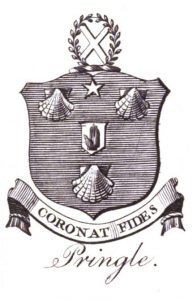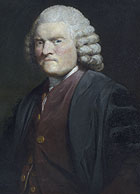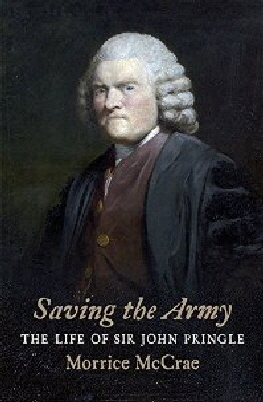Dr Sir John Pringle
Dr. Sir John Pringle of Pal Mall, Bart. M.D. F.R.S. (1707-1782)
Scottish physician and President of the Royal Society

Sir John was born at Stitchel House on April 10th 1707. He was the youngest son of Sir John Pringle of Stitchel, 2nd Bart. His mother was Magdalen Elliot, sister of Sir Gilbert Elliot of Stobs near Hawick.
His early education was at home with a private tutor, followed by attendance at St Andrew’s University where he stayed with a relation, Francis Pringle, who was Professor of Greek. Having decided that being a physician was the line that he wanted to follow, he spent time at Edinburgh and then at Leyden where, in 1730, he received his diploma.
He returned to Edinburgh, and in a very short time, was so well-known and respected that he was appointed assistant and successor to the Professor of Pneumatics and Moral Philpsophy at Edinburgh University. His appointment as physician to the Earl of Stair, Commander of the Army in Flanders, soon followed, and this led to his appointment as physician to the Military Hospital in Flanders. There he was able to study a wide range of medical problems and, as a result this research, was able, later, to publish his ‘Treatise on the Diseases of the Army’. When the Earl of Stair was replaced by the Duke of Cumberland, Pringle’s star rose even higher and he was appointed, in March 1745, Physician-General to the forces in the Low Countries and physician to the Royal Hospitals in those countries. This meant spending so much time away from home that he resigned his Professorship at Edinburgh. Later that year he was elected Fellow of the Royal Society.
Following the Duke of Cumberland, he spent the next year with the ‘Redcoat’ army in Scotland, including being at the Battle of Culloden. He then returned to England, before being posted abroad again during 1747 and 1748.
After the peace of Aix-la-Chapelle, he returned to London where he became Physician in Ordinary to the Duke of Cumberland, and worked as a physician in the city. As a result of his knowledge of diseases of people living in close quarters, he published a paper on Jail and Hospital Fever. This was the start of Dr Pringle the scientific researcher.
The regular publication of papers through the Royal Society gave him a great reputation in the scientific world. One on septic and antiseptic substances led to his being awarded the Sir Godfrey Copley Gold medal.
In 1752, he married Charlotte Oliver, the daughter of Dr Oliver of Bath, an eminent physician. Unfortunately she died within a few years, leaving him with no offspring. His great work on the diseases of the army was published, and in 1761 he was appointed Physician to Queen Charlotte’s household. Rising through the ranks of Physician within the Royal Household led to his being created Baronet in 1766, and in 1768, Physician in Ordinary to the King’s mother, the Princess of Wales, followed in 1774 by his final appointment as Physician Extraordinary to the King, George III.
In 1772, he had been elected President of the Royal Society, a singular honour.
He decided to retire in 1778 and returned to his native heath, where unfortunately he failed to settle. In 1781, having found the weather too cold and windy, and the company too limited, he returned to London where his health began to fail and on 18th January 1782, he died after a seizure.
He left the bulk of his hard-earned money to his nephew, Sir James Pringle of Stitchel, who also inherited the British Baronetcy along with that of Nova Scotia which the family already possessed.
So passed away a physician and philosophical enquirer of the first order. He is remembered by a monument in Westminster Abbey by Nollekins.

Links about Sir John Pringle:
BBC News: Sir John Pringle’s Historical Manuscripts on display.
Sir John Pringle: hospital reformer, moral philosopher and pioneer of antiseptics. by Sydney Selwyn.
A Mathematical and Philosophical Dictionary: Sir John Pringle, by Charles Hutton
Royal College of Physicians, Munk’s Roll: Sir John Pringle.
Sir John Pringle and his circle, by Dorothea Waley Singer
Sir John’s Memorial in Westminster Abbey
Burial Place: St James’s Church, Piccadilly
Sir John Pringles watch in the Royal Collection
Colour portrait of Sir John Pringle at the Wellcome Collection
Online books by Dr John Pringle:
Observations on the diseases of the army, by Dr Sir John Pringle, Bt.
The life of General James Wolfe, the conqueror of Canada, by Dr Sir John Pringle, Bt.
Six Discourses, by Dr Sir John Pringle, Bt.

Saving the Army: The Life of Sir John Pringle by Dr Morrice McCrae.
Publication Date: 4 Sep 2014. Available to purchase on Amazon.co.uk. The biography's launch took place in the New Library, Royal College of Physicians, 9 Queen Street, Edinburgh on Monday 3rd November 2014.
